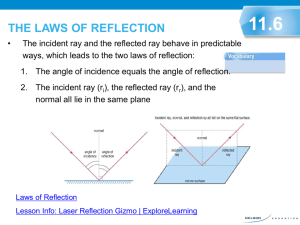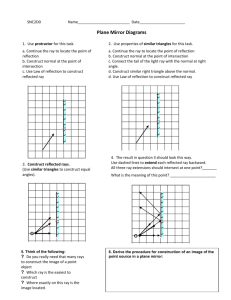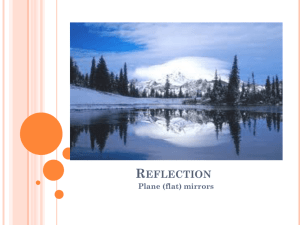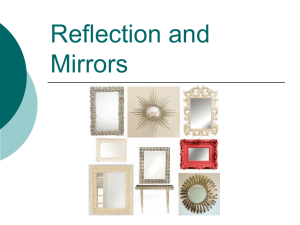reflection Slides - sacss-science
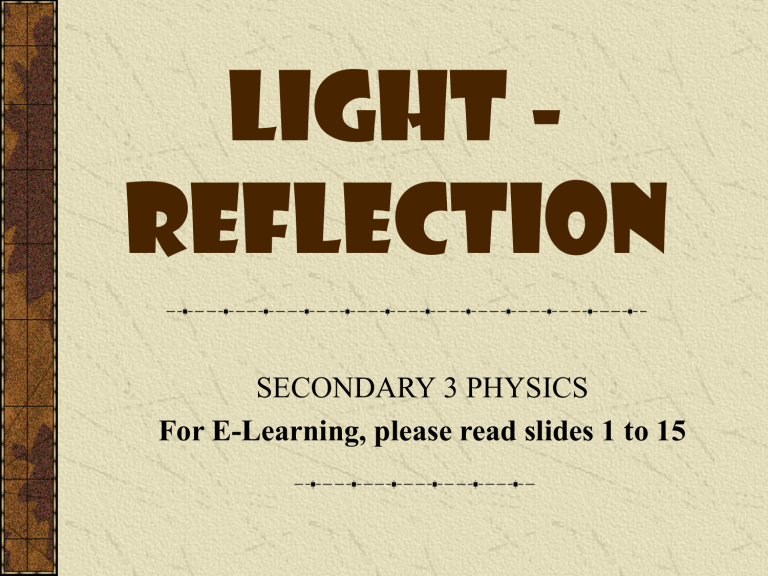
Light -
Reflection
SECONDARY 3 PHYSICS
For E-Learning, please read slides 1 to 15
What is Light?
Light is the part of the Electromagnetic (EM) spectrum which we can see.
Light travels in straight lines called rays .
A bundle of rays is known as a beam of light.
A ray A parallel beam
A divergent beam
A convergent beam
Properties of Light
1 Light travels in a straight line.
2 Light travels at a speed of 3
10 8 m/s.
3 Light can travel through vacuum.
4 Light is a wave that carries energy
(light energy) from one place to another.
Luminous and Non-Luminous
Luminous objects are objects that give off light on its own.
Example: Light bulb, Sun
We can see a luminous object when light from it enters our eyes.
Luminous and Non-Luminous
Non-luminous objects are objects that do not give off light on its own.
Example: table, board, Moon
We can see a non-luminous object when they reflect light from a light source into our eyes.
Seeing a luminous and a nonluminous object
Light from the lamp enters observer’s eyes directly enabling him to see the lamp
Reflection
Reflection is the bouncing of light rays off a surface.
We are able to see non-luminous objects as light is reflected off them.
Reflection Terminology
Incident ray
Angle of incidence, i normal
Angle of reflection, r
Reflected ray surface
What is the angle of incidence?
ANSWER: normal
Angle of incidence
= 90 o – 35 o
= 55 o
Incident ray
35 o
NOTE : Angle of incidence is between the normal and the incident ray surface
Laws of Reflection
The incident ray, the reflected ray and the normal all lie on the same plane.
The angle of incidence is equal to the angle of reflection.
Reflection for Different Surfaces
Regular reflection
•On smooth surfaces
Diffused reflection
•On rough surfaces
Regular Reflection
smooth surface
When light reflects from a smooth surface, it maintains its geometry. Parallel incident rays are reflected as parallel reflected rays and a clear image is obtained.
Diffuse Reflection
When a reflecting surface is rough, diffuse reflection occurs.
rough surface
The law of reflection still holds, but incident parallel rays do not reflect as parallel rays any more.
In diffuse reflection, the reflected rays leave the surface at so many different directions such that the image is disrupted.
Regular and Diffuse Reflection
On a mirror or a calm water surface, regular reflection occurs. The image formed on such surfaces are clear and sharp .
However, if the surface is rough, or the water surface is disturbed, diffuse reflection occurs. The image formed is blur.
Properties of Image Formed by a
Plane Mirror
Same size as the object
Laterally inverted (leftto-right inversion)
Upright
Virtual (image cannot be caught on a screen)
Object distance is equal to image distance
Drawing Ray Diagrams
There are many light rays reflected from an object to reach the mirror surface. However, only some light rays will be captured by the eyes.
object
Only this ray enters the eye and enables it to see the image plane mirror
To view the image of an object in a mirror, the eye should be positioned along the direction where the reflected rays from the mirror can be captured by the eye.
Drawing Ray Diagrams
To the eye, the light ray reaching the eye appears to come from the image behind the mirror.
object plane mirror
This type of image is called a virtual image because it is formed at a place where there is no light from the object.
The mirror simply makes the light appear to be coming from behind it.
Drawing Ray Diagrams
Steps involved in drawing ray diagrams
Supposing a triangular object is placed in front of a mirror. We can draw a ray diagram to show how the eye sees the image in the mirror. object x cm plane mirror x cm image
1 st - draw the image of the triangle, such that it is of the same size and same shape, as far behind the mirror as the object is in front.
Drawing Ray Diagrams
2 nd – draw two diverging rays from any point on the image towards where the eye is positioned.
object plane mirror image
3rd – draw two diverging rays from the corresponding point on the object to the mirror to meet the reflected rays.
Let’s revise how to draw ray diagram
Object, O
Image, I observer
Test Yourself!
Which direction is the light ray actually coming from?
(a) Sarah S went shopping with Caroline C one Sunday afternoon. Both girls stood in front of a shop admiring the window display.
(i) Mark Caroline’s image on the glass window, at appropriate position.
(ii) Draw ray diagrams to show how Sarah can see her friend by reflection on the shop window glass.
Where should you mark Caroline’s image on the glass window? Why?
S C wall Shop window wall
Ray diagram Practice
1
(b) Caroline moves away from Sarah to a new location
C’ to look at the display at the next shop.
S C
C’ i r wall Shop window wall
(i) Mark Caroline’s new image position
(ii) Show by ray diagram, whether Sarah can still see her friend by reflection.
(ii) Explain how your ray diagram helps you conclude on whether Caroline can be seen by reflection.
Light rays from Caroline can still be reflected on the glass window, obeying the Laws of Reflection, where i
= r
.
